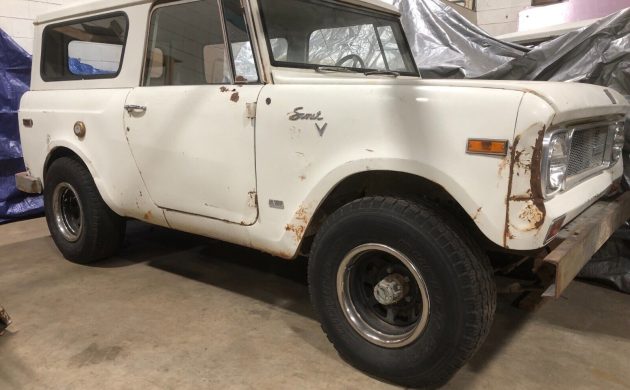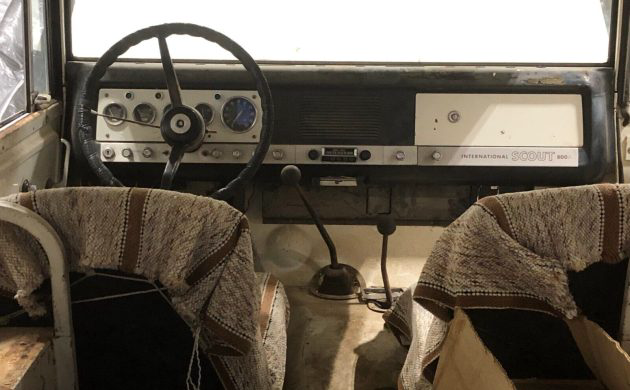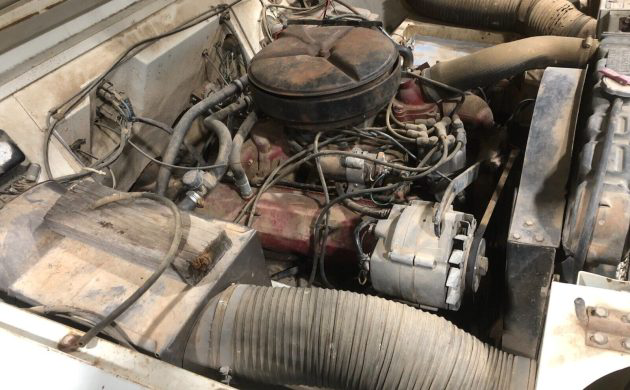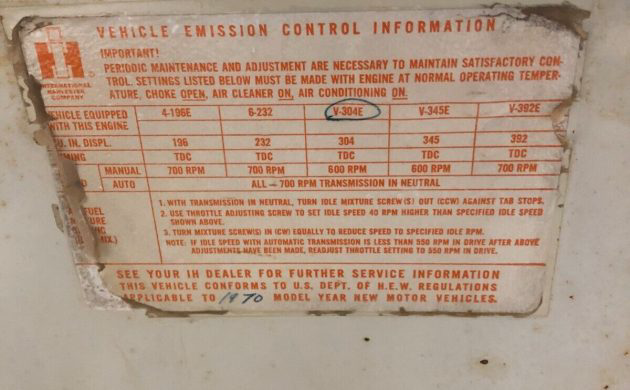Low Production Survivor: 1970 International Harvester Scout 800B

International Harvester built over 500,000 Scouts from 1960 to 1980 so they are not rare. Many, if not a majority of the production, has succumbed to what they were intended to be used for or the rust bug has finally caught up with them. This 1970 International Harvester Scout 800 is listed here on eBay with a Buy It Now Price of $18,500. There are 21 days remaining in the listing which started just a few days ago. The Scout has been stored for over 28 years and is located in Roscoe, Illinois. The odometer reading shows 62,010 miles which are stated to be the original mileage.

One might ask why is this particular Scout 800 rare other than it is a survivor. Well, the first Scout was built by International Harvester and called a Scout 80. Production for the Scout 80 ran from 1960 to 1965. The second generation of Scout was called the Scout 800 which was produced in three sub-models (800, 800A, and 800B). The Scout 800 was produced by International Harvester from 1966 to 1971. From 1966 to 1967, it was called the Scout 800. Starting in 1968, the Scout 800A was produced from 1968 to 1970. The Scout 800B had a short production run of only a few months from August 1970 to March 1971. I believe this is a Scout 800B. The Scout II replaced the Scout 800B and had a 10 year production run from 1971 to 1980.

Early International Harvester Scout 80s built from 1960 to 1980 were equipped with a 152 cubic inch inline four-cylinder engine rated from the factory at 93 gross horsepower. This was also the base engine for the Scout 800 but it could also be ordered with a turbocharger. This Scout 800 is equipped with the 304 cubic inch V8 engine. Other engines available in 1970 included the 196 cubic inch inline 4-cylinder was introduced in 1966, a 232 cubic inch six cylinder, a 345 cubic inch V8 engine and a 392 cubic inch V8 engine was also listed but I could not verify that this was available in Scouts. Later in the mid 1970s, a Nissan SD33 198 cubic inch diesel inline 6 could be ordered in a Scout II (1976-1979).

This 1970 International Scout 800 is said to be unrestored and in original condition. It has resurfaced after spending its entire existence in Southern Nebraska and subsequently being moved to long-term storage. The seller states it has been stored for over 28 years alongside other vehicles, some of which will be available for sale in the coming months. There are some dents and dings and we will see if it will sell for the listed price of $18,500.
Auctions Ending Soon
 2006 Ford Mustang Saleen S281 SCBid Now15 hours$15,000
2006 Ford Mustang Saleen S281 SCBid Now15 hours$15,000
 2002 Subaru Impreza WRXBid Now3 days$333
2002 Subaru Impreza WRXBid Now3 days$333
 1975 Chevrolet Corvette ConvertibleBid Now3 days$3,000
1975 Chevrolet Corvette ConvertibleBid Now3 days$3,000
 1964 Ford F-100 Camper CustomBid Now3 days$2,000
1964 Ford F-100 Camper CustomBid Now3 days$2,000
 2006 Jeep Wrangler SportBid Now5 days$10,500
2006 Jeep Wrangler SportBid Now5 days$10,500

Comments
If you look real close at the dash, it says 800A. I could’ve sworn the biggest V8 available in a first generation Scout was a 266, guess I learned something new. This really is a nice one, well worth restoring. And the price is right in line with everything else these days
Ybloclker, In 67, 5 of us bought, at the same time, on the same night, 5 new identical Scout 800’s, with the V8. First Yes 266 V8. On the engine tag shown, there is no 266 available in 70. Now as per Paul Harvey, the rest of the story.
When the IH production line was slow, not only Scouts, but other models, IH would run a bunch of identical vehicles, all painted the same color and offer them to dealers in lot’s of 5 for a special price. My Brother-in Law stopped by seeing them on dealers lot inquire of buying one. Dealer (owner) said if you can get 4 other’s and you buy all 5, I’ll give you all the identical deal. He got me and 3 others and we bought them. Next we all had Fisher 7 foot plows put on there as he was a Fisher dealer. The conventional plow frame for the 4 cyl Scout could not be put on the V8. Fisher used the “Suburbanite Hitch”. The lift cylinder was on the plows A frame with 2 chains going up to slots in bumperettes. It worked very well
I drove a snowplow prepped IH half ton 4×4 with the 394 in the early 70s. It could get up and go (rubber in 2nd and 3rd on a granny geared 4 speed). A Scout with that engine would have been a real handful so I doubt it was offered by the factory.
Sold mine 10 years ago. Glad to be rid of it. Needed 5 men and Charles Atlas to turn the darn steering wheel (manual). Ran good, but it was NO pleasure to drive (50 MPH top speed down hill with a hurricane wind behind. Traded up to a 4 X 4 Silverado with power steering, all hydraulic plow and V8, radio & heater (that worked). Oh, and it loved to rust – not rest – rust!
I say this with a big LOL, what would you want from a 44 yr old, 10 yrs ago, 1970 Scout. Apparently it needed some mechanical attention. Be NOT offended, NOT criticizing You, Just defending the Scout.
I’ve had several of these, various years/models. I found that a V8 worked great in the 80/800 frame, and can still do highway speeds–though not freeway raceway speeds.
One thing that really strikes me is that when going on a mountain road with deep dips the 80/800’s did not bottom out, but rather, rolled through the dips, since many old roads had been designed for such short vehicles–and, the Scouts, for those roads.
You will also see on that Emissions sticker, that the engines were to be times on TDC, top dead center. If you try that as my altitude, in the Rocky Mountains, the engine won’t even start. TDC is for sea level.
Some custom re-jetting of the carb might have helped too.
’S Y I bought my 1st gen bronk in ’82. Wanted this (or the 80, no Scout II, plez). But… they dropped their ‘light duty trucks’ @ that time.
Here’s a resource for all BF writers (C *** below). I’d say one must go thru it 1st B4 writing anything. It is not user-friendly 4 me as I have “an antique” puter. But it IS useable. Perhaps our writers dont have business models and work remote.
That might be difficult like my own. One could call up the specific M/M/Y and look at all the specs, then (if wanting) scan thru the same gen ‘face lifts’, options, etc, all the stuff of interest. What happens is we C the thumbnail pic, then go to the write-up. Sometimes we no ALL abt the model, sometimes we come to learn more. In the latter case the writer (if following this standard) could provide that.
I believe the last yrs scouts had 2 different diesels – the 33 listed but an earlier model had the SD32. The 33 was turboed & the 32 not. Again use of the below can often solve these Qs.
https://www.automobile-catalog.com/make/international-harvester/scout_80_800/scout_800a_wagon/1970.html#gsc.tab=0
have fun, thnx 4 da pic/article
Bigger the engine, heavier the engine, knuckle bearings were most likely the issue with the difficult steering, the lower bearing will be chewed up in a matter of years if going up logging roads with a lot of ruts.
There wasn’t anything wrong with the steering, some guys just aren’t up to the task of driving a vehicle with manual steering, it’s really not that tough, years ago, everybody had to do it, including women lol
Yblocker, agree on what your saying. Even Atlas is not turning the wheel unless the vehicle slightly moving. Don’t remember if 70 had open or closed steering knuckles. Closed had tapered roller bearings top and bottom with a lubricant fill plug and lube slung around when front axel engaged. They were easy steering and with age moisture and contaminants would damage the lower bearing which carries ALL the weight. I believe open knuckles used ball joints.
Man this scout brings back memories. My father had one just like this but I believe his was a 68 or 69. It was green with a white roof. My father had it for his trucking business. He let one of the mechanics take it home on a snowy night and he rolled it. It ended up on its wheels and he drove it back to the shop. They removed the top and straightened the windshield frame and installed a new windshield. My father got from international what they called a half cab and then it was like a pickup. He had it for many years. These are really tough and reliable trucks and that’s no bs. GLWTA